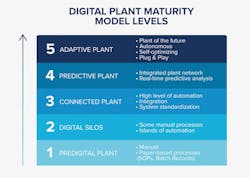The hype around Industry 4.0 has reached a fever pitch in recent years, fueled by advances in digital technologies and their potential to revolutionize the manufacturing landscape. Industry 4.0 is characterized by the integration of cutting-edge technologies such as artificial intelligence (AI), the Internet of Things (IoT), Big Data analytics and advanced robotics, promising a new era of smart, interconnected and self-optimizing factories.
While there is no doubt these technologies have the potential to transform industry, the hype surrounding Industry 4.0 also raises concerns about unrealistic expectations and the risk of overlooking the challenges and complexities associated with implementation. Striking a balance between embracing the potential of Industry 4.0 and maintaining a realistic perspective on the required investments, change management and integration efforts are critical to achieving long-term success.
Creating a road map
For AI to benefit your manufacturing environment, you must first determine your plant's readiness to undertake an AI or Big Data investment. The Plant Maturity Model is a strategic framework used to assess and guide the implementation of digital technologies within manufacturing facilities. It typically consists of multiple stages, ranging from basic automation and data collection to advanced integration and optimization of manufacturing processes. By evaluating a plant's current maturity level, organizations can identify gaps, prioritize areas for improvement, and create a roadmap for digital transformation.
Evaluate AI’s suitability first
It's important to understand the types of problems AI can effectively address in a manufacturing context. Following are six factors to consider when determining if your manufacturing problem is a good fit for AI:
- Data availability.AI, particularly machine learning models, requires significant amounts of quality data to learn and perform effectively. If you have access to ample, relevant data for the problem, AI might be a viable option.
- Complexity. AI excels at tackling complex, multifaceted problems involving numerous variables or pattern recognition. If your manufacturing issue is intricate, AI could be suitable.
- Repetitive tasks.AI can efficiently automate repetitive tasks such as inspections, quality control or data analysis. If your problem involves time-consuming, repetitive tasks that can be automated, AI might be beneficial.
- Predictive analytics. AI is adept at forecasting future outcomes based on historical data, such as demand forecasting, equipment failure prediction or process optimization. If your problem can benefit from predictive analytics, AI may be a suitable approach.
- Adaptability. AI models can learn and adapt to changes in the manufacturing environment, offering a significant advantage in dynamic settings. If your problem requires technology that can adapt to evolving conditions, AI might be the right fit.
- Scalability. AI can often be easily scaled to handle large amounts of data or be applied to multiple production lines or factories.
Reasons for caution
When implementing AI in manufacturing, it's crucial to keep the following considerations in mind:
- Define clear objectives. Begin by clearly defining the objectives of your AI implementation. Identify the specific problems you want to address and set measurable goals. This will help you choose the right AI technology and track its effectiveness over time.
- Data quality and availability. AI, especially machine learning models, rely on large amounts of high-quality, representative data to learn from. Ensure that you have access to the necessary data and that it is clean, accurate and well-structured. Investing in proper data management practices first is essential for a successful AI implementation.
- Integration with existing systems. Consider how the AI technology will integrate with your existing manufacturing systems, including hardware, software and communication protocols. Seamless integration is crucial for efficient operation and minimized disruptions.
- Skills and expertise. AI implementation requires a multidisciplinary team with expertise in AI, data science, manufacturing processes, and OT and IT infrastructure. Assess your current team's capabilities and identify any gaps that may need to be filled through hiring, training or partnering with external experts.
- Partners. Selecting the right partners is a critical factor for successful AI integration in manufacturing. Collaborating with experienced partners who have complementary skills, expertise and a proven track record can significantly enhance the effectiveness and overall value of your AI implementation.
- Change management. Implementing AI can cause significant changes in the way your manufacturing process operates. Effective change management is crucial to ensure smooth adoption and minimize resistance from your workforce. Communicate the benefits of AI, provide the necessary training and actively involve employees in the implementation process.
Dan Riley is Analytics Manager at Interstates, a certified member of the Control System Integrators Association (CSIA). For more information about Interstates, visit its profile on the Industrial Automation Exchange.


